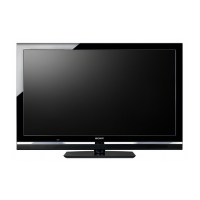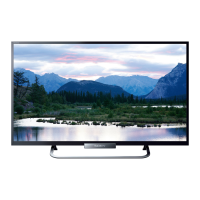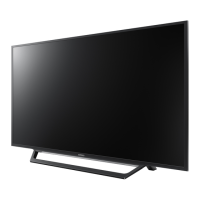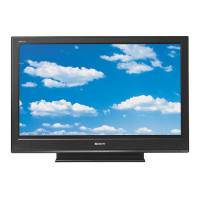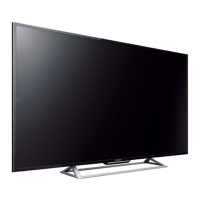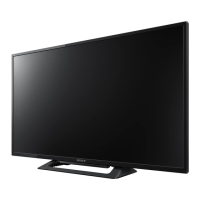Do you have a question about the Sony KDL-32W5500 and is the answer not in the manual?
Lists the specific Sony BRAVIA TV models covered by this manual.
Specifies the product as an LCD Digital Colour TV.
Welcomes the user and advises reading the manual thoroughly.
Details trademarks, logos, and licensing agreements used in the manual.
Crucial safety advice regarding the stable positioning of the television to prevent falls.
Specific notes pertinent to Australia and New Zealand models, focusing on energy rating.
Lists essential accessories to check before beginning TV setup.
Step-by-step instructions for securely attaching the TV's stand.
Guidance on connecting aerials, antennas, and VCRs to the TV.
Instructions on how to secure the TV to prevent it from toppling over.
Recommendations for properly bundling and organizing cables connected to the TV.
Steps for performing the initial setup and configuration of the TV.
Instructions on how to adjust the TV screen's angle for optimal viewing.
Procedures for safely removing the TV's table-top stand.
Comprehensive guidelines for safe and proper TV installation.
Safety measures to follow when transporting the television to prevent damage or injury.
Essential information on maintaining adequate ventilation for the TV.
Precautions for safe handling of the AC power cord and electrical connections.
Details on locations and situations where the TV should not be operated.
Safety procedures if the TV screen is damaged or cracked.
Guidelines for safely disconnecting the TV when it is not in use.
Measures to ensure child safety concerning TV accessories and climbing.
Actions to take if specific problems arise, including unplugging and contacting service.
Advice on optimal viewing conditions and safe cleaning practices for the screen.
Safety considerations for optional equipment and proper battery disposal.
Information on the environmentally responsible disposal of the television.
Identification of buttons and features on the remote control.
Description of buttons and indicators located directly on the TV.
Explanation of the energy saving switch and its operational impact.
How to use navigation and media playback controls on the remote.
Methods for accessing program information and teletext services.
Using remote buttons to access the program guide and favourite lists.
How to select channels and apply scene modes for picture and sound.
Controls for audio adjustments and BRAVIA Sync features.
Switching between digital/analogue modes and using Picture-in-Picture.
Explanation of the various indicator lights on the TV unit.
Details on the detection range and location of the presence sensor.
Information on how to access and utilize the on-screen operation guide.
How to turn the TV on and switch between digital and analogue modes.
Selecting channels and understanding the digital information banner.
Instructions for accessing and navigating teletext services.
How to change the picture's aspect ratio using Wide Mode settings.
Step-by-step guide to accessing and using the Digital Electronic Programme Guide.
How to set reminders for programmes and manage timer entries.
Procedures for adding, watching, and removing analogue favourite channels.
How to manage up to four digital favourite channel lists.
Detailed steps for adding or removing channels from favourite lists.
How to select and watch channels directly from configured favourite lists.
Overview of connecting various audio and video devices to the TV.
Instructions for connecting digital audio systems and home theatre systems.
Specific instructions for connecting equipment via HDMI, component, and S-video.
Procedures for connecting optical audio, standard audio, and USB devices.
How to connect a PC and set up network connectivity via LAN.
Instructions for connecting headphones to listen to TV audio.
How to select the desired input source from connected equipment.
Instructions for using Picture-in-Picture (PIP) and Twin Picture modes.
Steps to connect USB storage devices and cameras for media playback.
How to navigate and play photo, music, and video files from USB devices.
Information on the automatic photo playback feature when the TV powers on.
How to use the TV as a digital photo frame.
How to adjust the duration for which photos are displayed in Picture Frame mode.
Using GPS data to display photos with their associated location on a map.
Explanation of BRAVIA Sync features and HDMI Control for connected devices.
Guidelines for connecting devices compatible with HDMI control.
Steps for setting up HDMI control on both the TV and connected equipment.
Overview of sharing content from DLNA-compatible devices on a home network.
Instructions for establishing a network connection for the TV.
How to access and play media files stored on network servers.
Lists the supported file formats for media playback over the network.
How to use the Renderer feature to control media playback from other devices.
Procedures for testing and diagnosing the TV's network connection.
How to select which network servers appear on the Home Menu.
Steps for diagnosing and resolving problems with network server recognition.
Guide to navigating the XMB™ menu for accessing TV features and settings.
Explanation of the icons representing different media categories in the menu.
Introduction to the main sections within the TV Settings menu.
How to set sleep timers, on timers, and manually adjust the clock.
Configuration of eco settings and power saving features for reduced consumption.
Information on presence sensor functionality and idle TV standby settings.
An overview of picture settings, including target inputs and various picture modes.
Comprehensive options for fine-tuning picture quality parameters.
Advanced settings to further enhance and customize picture quality.
Introduction to sound settings, including target inputs and sound modes.
Various settings for adjusting sound output, including volume, balance, and enhancers.
How to select and apply different surround sound effects.
Adjusting screen settings like Wide Mode and Display Area for external inputs.
Specific screen adjustments applicable when the TV is connected to a PC.
How to configure the colour system based on input signal type.
Configuring audio output for TV speakers, external systems, and headphones.
Configuration options for USB auto start and quick start features.
Assigning labels to equipment and managing input sources.
Adjusting video modes and setting up HDMI control for connected devices.
Managing the HDMI device list and setting up auto TV on feature.
Options for language, product information, and resetting TV to factory settings.
Procedures for setting up analogue channels, including list display and sorting.
Assigning custom labels to channels and blocking specific channel content.
Using intelligent picture features and manually tuning channels.
Settings for digital channels, including subtitles, audio, and programme sorting.
Manually tuning digital channels and configuring radio display options.
Setting up parental controls and managing the PIN code for content restrictions.
Managing automatic service and system software updates.
Configuring IP addresses, DNS servers, and network parameters.
Managing server display preferences and diagnosing network server connections.
Setting up renderer access control and defining renderer permissions.
Guidance for installing the optional wall-mount bracket.
Critical safety warning regarding the required wall strength for TV mounting.
A table providing dimensions for wall-mount bracket installation.
Diagrams illustrating screw and hook locations for attaching the wall-mount bracket.
Comprehensive technical specifications for each TV model.
Technical details of the TV's input and output jacks.
Specifications for power requirements, screen size, and display resolution.
Physical dimensions, mass, and supplied accessories for the TV models.
Chart detailing compatible PC input signals and resolutions.
Interpreting flashing standby indicator lights for self-diagnosis.
Solutions for common issues related to picture and sound quality.
Troubleshooting steps for connectivity, blank channels, and digital channel reception.
Steps to resolve network connection failures and diagnostic errors.
Solutions for issues with server not found or incorrect content display.
Troubleshooting common operational problems like power, standby, and remote control malfunctions.
Resolving issues with HDMI equipment recognition and channel tuning problems.
Lists the specific Sony BRAVIA TV models covered by this manual.
Specifies the product as an LCD Digital Colour TV.
Welcomes the user and advises reading the manual thoroughly.
Details trademarks, logos, and licensing agreements used in the manual.
Crucial safety advice regarding the stable positioning of the television to prevent falls.
Specific notes pertinent to Australia and New Zealand models, focusing on energy rating.
Lists essential accessories to check before beginning TV setup.
Step-by-step instructions for securely attaching the TV's stand.
Guidance on connecting aerials, antennas, and VCRs to the TV.
Instructions on how to secure the TV to prevent it from toppling over.
Recommendations for properly bundling and organizing cables connected to the TV.
Steps for performing the initial setup and configuration of the TV.
Instructions on how to adjust the TV screen's angle for optimal viewing.
Procedures for safely removing the TV's table-top stand.
Comprehensive guidelines for safe and proper TV installation.
Safety measures to follow when transporting the television to prevent damage or injury.
Essential information on maintaining adequate ventilation for the TV.
Precautions for safe handling of the AC power cord and electrical connections.
Details on locations and situations where the TV should not be operated.
Safety procedures if the TV screen is damaged or cracked.
Guidelines for safely disconnecting the TV when it is not in use.
Measures to ensure child safety concerning TV accessories and climbing.
Actions to take if specific problems arise, including unplugging and contacting service.
Advice on optimal viewing conditions and safe cleaning practices for the screen.
Safety considerations for optional equipment and proper battery disposal.
Information on the environmentally responsible disposal of the television.
Identification of buttons and features on the remote control.
Description of buttons and indicators located directly on the TV.
Explanation of the energy saving switch and its operational impact.
How to use navigation and media playback controls on the remote.
Methods for accessing program information and teletext services.
Using remote buttons to access the program guide and favourite lists.
How to select channels and apply scene modes for picture and sound.
Controls for audio adjustments and BRAVIA Sync features.
Switching between digital/analogue modes and using Picture-in-Picture.
Explanation of the various indicator lights on the TV unit.
Details on the detection range and location of the presence sensor.
Information on how to access and utilize the on-screen operation guide.
How to turn the TV on and switch between digital and analogue modes.
Selecting channels and understanding the digital information banner.
Instructions for accessing and navigating teletext services.
How to change the picture's aspect ratio using Wide Mode settings.
Step-by-step guide to accessing and using the Digital Electronic Programme Guide.
How to set reminders for programmes and manage timer entries.
Procedures for adding, watching, and removing analogue favourite channels.
How to manage up to four digital favourite channel lists.
Detailed steps for adding or removing channels from favourite lists.
How to select and watch channels directly from configured favourite lists.
Overview of connecting various audio and video devices to the TV.
Instructions for connecting digital audio systems and home theatre systems.
Specific instructions for connecting equipment via HDMI, component, and S-video.
Procedures for connecting optical audio, standard audio, and USB devices.
How to connect a PC and set up network connectivity via LAN.
Instructions for connecting headphones to listen to TV audio.
How to select the desired input source from connected equipment.
Instructions for using Picture-in-Picture (PIP) and Twin Picture modes.
Steps to connect USB storage devices and cameras for media playback.
How to navigate and play photo, music, and video files from USB devices.
Information on the automatic photo playback feature when the TV powers on.
How to use the TV as a digital photo frame.
How to adjust the duration for which photos are displayed in Picture Frame mode.
Using GPS data to display photos with their associated location on a map.
Explanation of BRAVIA Sync features and HDMI Control for connected devices.
Guidelines for connecting devices compatible with HDMI control.
Steps for setting up HDMI control on both the TV and connected equipment.
Overview of sharing content from DLNA-compatible devices on a home network.
Instructions for establishing a network connection for the TV.
How to access and play media files stored on network servers.
Lists the supported file formats for media playback over the network.
How to use the Renderer feature to control media playback from other devices.
Procedures for testing and diagnosing the TV's network connection.
How to select which network servers appear on the Home Menu.
Steps for diagnosing and resolving problems with network server recognition.
Guide to navigating the XMB™ menu for accessing TV features and settings.
Explanation of the icons representing different media categories in the menu.
Introduction to the main sections within the TV Settings menu.
How to set sleep timers, on timers, and manually adjust the clock.
Configuration of eco settings and power saving features for reduced consumption.
Information on presence sensor functionality and idle TV standby settings.
An overview of picture settings, including target inputs and various picture modes.
Comprehensive options for fine-tuning picture quality parameters.
Advanced settings to further enhance and customize picture quality.
Introduction to sound settings, including target inputs and sound modes.
Various settings for adjusting sound output, including volume, balance, and enhancers.
How to select and apply different surround sound effects.
Adjusting screen settings like Wide Mode and Display Area for external inputs.
Specific screen adjustments applicable when the TV is connected to a PC.
How to configure the colour system based on input signal type.
Configuring audio output for TV speakers, external systems, and headphones.
Configuration options for USB auto start and quick start features.
Assigning labels to equipment and managing input sources.
Adjusting video modes and setting up HDMI control for connected devices.
Managing the HDMI device list and setting up auto TV on feature.
Options for language, product information, and resetting TV to factory settings.
Procedures for setting up analogue channels, including list display and sorting.
Assigning custom labels to channels and blocking specific channel content.
Using intelligent picture features and manually tuning channels.
Settings for digital channels, including subtitles, audio, and programme sorting.
Manually tuning digital channels and configuring radio display options.
Setting up parental controls and managing the PIN code for content restrictions.
Managing automatic service and system software updates.
Configuring IP addresses, DNS servers, and network parameters.
Managing server display preferences and diagnosing network server connections.
Setting up renderer access control and defining renderer permissions.
Guidance for installing the optional wall-mount bracket.
Critical safety warning regarding the required wall strength for TV mounting.
A table providing dimensions for wall-mount bracket installation.
Diagrams illustrating screw and hook locations for attaching the wall-mount bracket.
Comprehensive technical specifications for each TV model.
Technical details of the TV's input and output jacks.
Specifications for power requirements, screen size, and display resolution.
Physical dimensions, mass, and supplied accessories for the TV models.
Chart detailing compatible PC input signals and resolutions.
Interpreting flashing standby indicator lights for self-diagnosis.
Solutions for common issues related to picture and sound quality.
Troubleshooting steps for connectivity, blank channels, and digital channel reception.
Steps to resolve network connection failures and diagnostic errors.
Solutions for issues with server not found or incorrect content display.
Troubleshooting common operational problems like power, standby, and remote control malfunctions.
Resolving issues with HDMI equipment recognition and channel tuning problems.
| Screen Size | 32 inches |
|---|---|
| Resolution | 1366 x 768 |
| Display Type | LCD |
| Backlight Type | CCFL |
| HDMI Ports | 4 |
| USB Ports | 1 |
| Audio Output | 10W x 2 |
| Refresh Rate | 50 Hz |
| Built-in Wi-Fi | No |
| Smart TV | No |
| 3D Capable | No |
